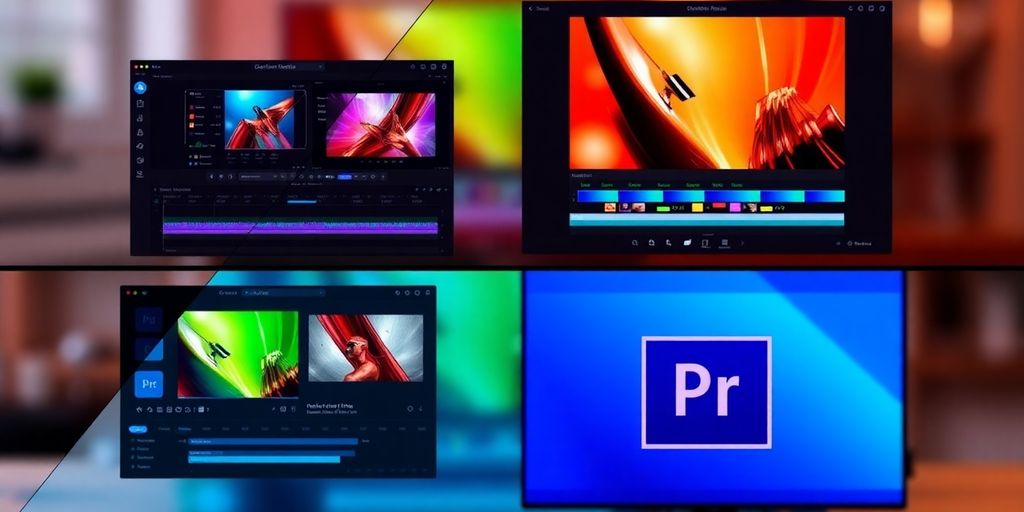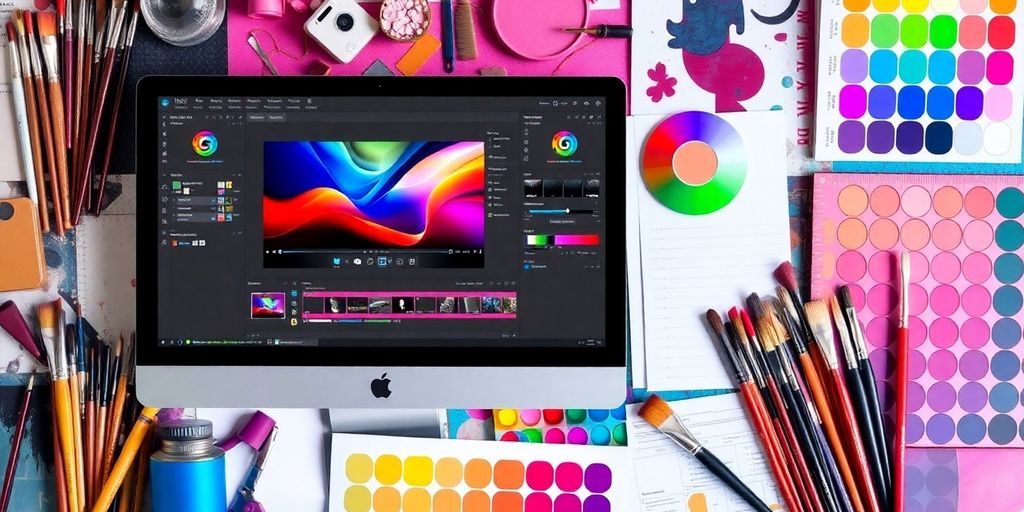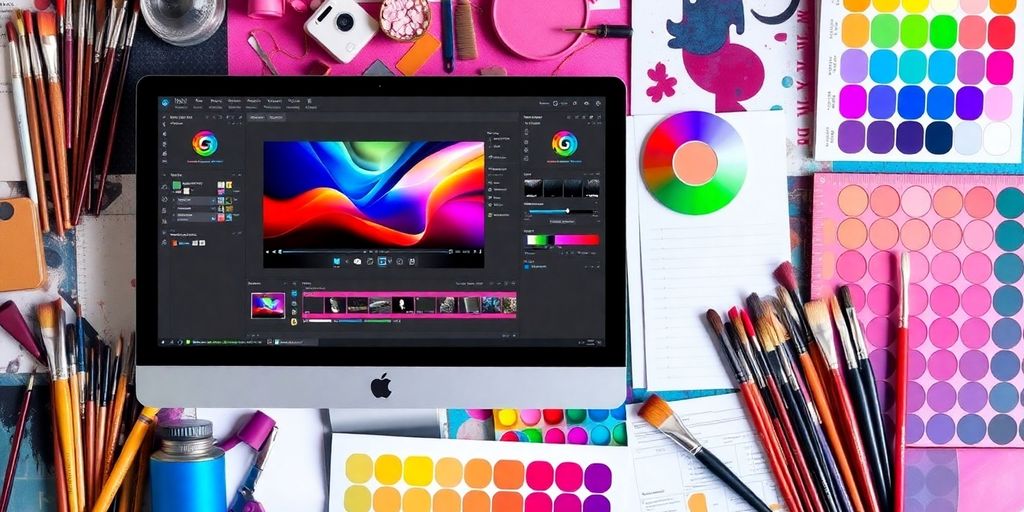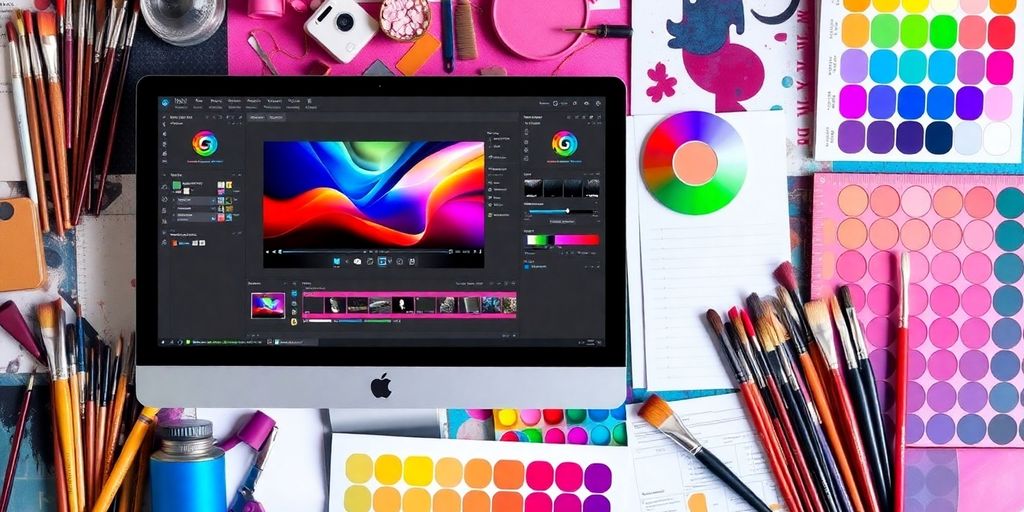Davinci Resolve vs Final Cut Pro vs Premiere Pro: Which Video Editing Software Reigns Supreme?

In the world of video editing, choosing the right software can be a game-changer. With so many options available, it can be tough to decide which one is the best fit for your needs. This article compares three of the most popular video editing programs: DaVinci Resolve, Final Cut Pro, and Premiere Pro. We’ll explore their user interfaces, performance, editing features, compatibility, pricing, community support, and future updates. By the end, you’ll have a clearer idea of which software might be the best choice for you.
Key Takeaways
- DaVinci Resolve shines in color correction, making it a favorite for those focused on visual quality.
- Final Cut Pro is user-friendly and great for beginners, thanks to its intuitive design and workflow.
- Premiere Pro excels in editing and audio capabilities, appealing to professional editors.
- Each software has unique strengths, so the best choice depends on your editing needs and style.
- Consider trying out free trials to see which software feels right for you before making a decision.
User Interface and Experience
Ease of Navigation
Navigating through video editing software can be tricky. Each program has its own layout and design. Here’s how they compare:
| Software | Navigation Ease | User Feedback |
|---|---|---|
| DaVinci Resolve | Moderate | Mixed |
| Final Cut Pro | Easy | Positive |
| Premiere Pro | Moderate | Positive |
Final Cut Pro is often praised for its intuitive layout, making it easier for beginners to find tools quickly.
Customization Options
Customization is key for many editors. Here are some options available in each software:
- DaVinci Resolve: Offers a flexible workspace that can be tailored to your needs.
- Final Cut Pro: Allows users to create custom keyboard shortcuts and layouts.
- Premiere Pro: Provides various panels that can be rearranged to suit your workflow.
Learning Curve
The learning curve can vary significantly between these programs:
- DaVinci Resolve: Steeper learning curve due to its advanced features.
- Final Cut Pro: Easier for beginners, especially those familiar with Apple products.
- Premiere Pro: Moderate; users with prior editing experience may adapt quickly.
The user experience is crucial in video editing software. A well-designed interface can make the editing process smoother and more enjoyable.
In summary, while all three software options have their strengths, Final Cut Pro stands out for its user-friendly interface, making it a favorite among new editors. For those looking for more advanced features, multicam editing in DaVinci Resolve and Premiere Pro can enhance the editing experience.
Performance and Speed
Rendering Times
When it comes to rendering times, Final Cut Pro 11 is a clear winner, outperforming Adobe Premiere Pro 25 by about five times for complex tasks. DaVinci Resolve 19.1 also shows impressive speed, being roughly twice as fast as Premiere for similar rendering jobs. Here’s a quick comparison:
| Software | Rendering Speed (Relative) |
|---|---|
| Final Cut Pro 11 | 5x faster than Premiere Pro |
| DaVinci Resolve 19.1 | 2x faster than Premiere Pro |
| Adobe Premiere Pro 25 | Baseline speed |
Software Stability
Stability is crucial for any video editing software. Users often report that Final Cut Pro is very stable, especially on Mac systems. In contrast, DaVinci Resolve can be more demanding on hardware, which may lead to crashes if the system isn’t powerful enough. Here are some points to consider:
- Final Cut Pro is known for its smooth performance on Mac.
- DaVinci Resolve may crash on less powerful machines, especially during heavy tasks.
- Adobe Premiere Pro has improved stability over the years but can still face issues with certain formats.
Hardware Requirements
The hardware you use can greatly affect performance. Here’s a brief overview of the requirements:
- Final Cut Pro: Optimized for Mac hardware, works best with M1 chips.
- DaVinci Resolve: Requires a powerful GPU for best performance, especially for color grading.
- Adobe Premiere Pro: Flexible but benefits from a good CPU and GPU combination.
In summary, the performance and speed of video editing software can vary greatly based on the tasks you are doing and the hardware you are using. Choosing the right software for your needs is essential.
Editing Features and Tools

Multicam Editing
Multicam editing is a powerful feature that allows editors to work with footage from multiple cameras. This is especially useful for events like concerts or interviews where different angles are needed. Here are some key points about multicam editing:
- Switch between camera angles easily during playback.
- Sync clips automatically based on audio or timecode.
- Create a seamless final product with smooth transitions.
Color Correction Capabilities
Color correction is essential for making videos look professional. Each software has its own tools for adjusting colors and lighting. Here’s a quick comparison:
| Software | Color Correction Tools | Advanced Features |
|---|---|---|
| DaVinci Resolve | Yes | Advanced color wheels |
| Final Cut Pro | Yes | Color grading presets |
| Premiere Pro | Yes | Lumetri Color panel |
DaVinci Resolve is known for its superior color grading tools, making it a favorite among professionals.
Audio Editing Tools
Good audio is just as important as good video. Each software offers different audio editing tools:
- DaVinci Resolve has a dedicated Fairlight page for advanced audio editing.
- Final Cut Pro provides basic audio tools but lacks some advanced features.
- Premiere Pro includes Adobe Sensei AI for auto-captioning and remixing music tracks.
In video editing, the right tools can make a huge difference in the final product. Choosing software with strong editing features is crucial for achieving the best results.
Overall, when comparing these three software options, it’s clear that each has unique strengths in editing features and tools. Whether you need advanced color correction, multicam editing, or audio editing capabilities, there’s a software that fits your needs.
Compatibility and Integration
Supported File Formats
When choosing video editing software, it’s crucial to consider the supported file formats. Each software has its strengths:
- DaVinci Resolve: Supports a wide range of formats, including RAW files, which is great for color grading.
- Final Cut Pro: Works seamlessly with Apple formats and offers good support for various video types.
- Premiere Pro: Known for its extensive format support, making it versatile for different projects.
Third-Party Plugin Support
The ability to use third-party plugins can enhance your editing experience. Here’s how each software stacks up:
- DaVinci Resolve: Offers some plugin support, but it’s more limited compared to others.
- Final Cut Pro: Has a robust ecosystem of plugins available for various effects and enhancements.
- Premiere Pro: Known for its extensive third-party plugin support, allowing for a customizable editing experience.
Cross-Platform Availability
Cross-platform compatibility is essential for collaboration. Here’s a quick overview:
- DaVinci Resolve: Available on Windows, macOS, and Linux, making it very flexible.
- Final Cut Pro: Exclusively for macOS, which can limit collaboration with Windows users.
- Premiere Pro: Available on both Windows and macOS, making it a popular choice for teams.
In the world of video editing, having the right tools that work well together can make a big difference in your workflow.
Understanding the compatibility and integration of these software options can help you make an informed choice based on your specific needs.
Pricing and Value
Subscription vs One-Time Purchase
When it comes to pricing, video editing software can vary greatly. DaVinci Resolve Studio and Final Cut Pro both require a one-time payment of $299 USD. In contrast, Adobe Premiere Pro operates on a subscription model, which can add up over time. Here’s a quick comparison:
| Software | Pricing Model | Cost (USD) |
|---|---|---|
| DaVinci Resolve Studio | One-Time Purchase | $299 |
| Final Cut Pro | One-Time Purchase | $299 |
| Adobe Premiere Pro | Subscription | $20.99/month (annual plan) |
Free Trial Availability
Most of these software options offer free trials, allowing users to test them out before committing. Here are the details:
- DaVinci Resolve: Free version available with limited features.
- Final Cut Pro: 90-day free trial.
- Adobe Premiere Pro: 7-day free trial.
Cost-Effectiveness for Professionals
For professionals, the choice often comes down to long-term costs and features. Here are some points to consider:
- One-time payment options like DaVinci Resolve and Final Cut Pro can be more cost-effective in the long run.
- Subscription models may provide access to regular updates and new features but can become expensive over time.
- Evaluate the features you need to determine which software offers the best value for your specific editing tasks.
Investing in the right video editing software can significantly impact your workflow and productivity. Choose wisely!
Community and Support

Online Tutorials and Resources
Many users find that there are plenty of online tutorials available for all three software options. These resources can help beginners and experienced editors alike. Here are some popular types of resources:
- Video tutorials on platforms like YouTube
- Written guides and blogs
- Community forums for troubleshooting and tips
Customer Support Quality
When it comes to customer support, each software has its strengths:
- DaVinci Resolve: Known for responsive support, especially for paid users.
- Final Cut Pro: Offers extensive documentation and user guides.
- Premiere Pro: Has a large community, but some users report slower response times.
User Community Engagement
The user communities for these editing programs are quite active. They often share tips, tricks, and experiences. Here are some ways users engage:
- Participating in forums and discussion boards.
- Attending webinars and live Q&A sessions.
- Joining social media groups focused on video editing.
Engaging with the community can greatly enhance your learning experience and help you solve problems faster.
Updates and Future Prospects
Frequency of Updates
The frequency of updates for video editing software can greatly impact user experience. Here’s how the three software options stack up:
| Software | Update Frequency |
|---|---|
| DaVinci Resolve | Regular updates, often monthly |
| Final Cut Pro | Frequent updates, typically quarterly |
| Premiere Pro | Regular updates, often monthly |
Innovative Features
Each software is constantly evolving, introducing new features to enhance editing capabilities. Some notable innovations include:
- DaVinci Resolve: Advanced color grading tools and seamless integration with Fusion for VFX.
- Final Cut Pro: Enhanced timeline navigation and organization, making complex edits easier to manage. FCPX 10.7 introduced these improvements.
- Premiere Pro: New collaborative features that allow multiple users to work on the same project simultaneously.
Long-Term Viability
When considering long-term use, it’s essential to evaluate:
- Community Support: A strong user community can provide valuable resources and support.
- Software Development: Continuous development indicates a commitment to improving the software.
- Market Trends: Keeping an eye on industry trends can help predict which software will remain relevant.
The future of video editing software is bright, with each platform striving to meet the evolving needs of creators. Staying updated with the latest features can significantly enhance your editing experience.
Final Thoughts on Video Editing Software
In the end, choosing between DaVinci Resolve, Final Cut Pro, and Premiere Pro really depends on what you need. DaVinci Resolve is great for color grading and is free, making it a solid choice for beginners and pros alike. Final Cut Pro is user-friendly and perfect for those just starting out, even if it costs $300. On the other hand, Premiere Pro has its loyal fans, but many users find it expensive and buggy. Each software has its strengths and weaknesses, so it’s best to try them out and see which one feels right for you. Remember, the best tool is the one that helps you tell your story the best.
Frequently Asked Questions
Which software is best for beginners: DaVinci Resolve, Final Cut Pro, or Premiere Pro?
For beginners, Final Cut Pro is often seen as the easiest to use. It has a simple layout that helps new users feel comfortable quickly. DaVinci Resolve is also a great choice, especially since it’s free and offers many powerful features.
Is DaVinci Resolve really better for color correction?
Yes, many users believe DaVinci Resolve has the best color correction tools available. It has advanced options that let you adjust colors in a very detailed way, making it popular among professionals.
How do the prices compare among these three software options?
Final Cut Pro requires a one-time payment of around $300, while Premiere Pro uses a subscription model costing about $21 per month. DaVinci Resolve offers a free version with a lot of features, plus a paid version for more advanced tools.
Can I use these software programs on different computers?
Final Cut Pro is only available for Mac, while Premiere Pro works on both Windows and Mac. DaVinci Resolve is also available on both platforms, making it more flexible for users.
What features should I look for when choosing video editing software?
When choosing software, consider the user interface, the editing tools available, how well it handles audio, and the support for different file formats. It’s also important to think about the learning curve and how much help is available online.
Do these software options provide good customer support?
All three software programs have various online resources, including tutorials and forums. However, the quality of customer support can vary, with many users finding DaVinci Resolve’s community very helpful.





Responses